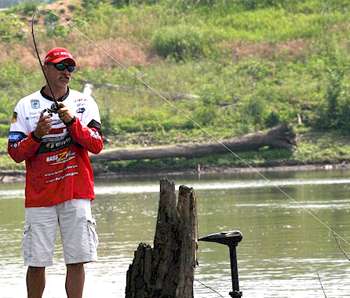
Classic summertime structure includes deep ledges, main lake humps and other electronics-straining bottom contours, but Oklahoma pro Vince Fulks knows that even on the hottest days of July and August, a certain percentage of the fish stay shallow all the time.
"Several studies have shown that the fish will move in and out of shallow water 12 months out of the year, even if the lake is frozen over," he says.
Like many of his peers on the Elite Series trail, he'll often start the mornings in pursuit of active feeders with a topwater bait, but when the others start to slink away to deeper haunts, he'll often stay right where he started — and continue to catch fish all day.
"As the sun gets up and you think the fish have moved deeper, there are still some fish that stay shallow all day long," he advises. The trick is to find them and then to pattern them.
"They're looking for food, so you want to concentrate on areas like walkways on docks," he says. "Look for the subtleties. Shallow water fish in the summertime can really, really pattern themselves. If you find one on a wind-blown point, then keep working those. Run that pattern."
Typically, that means not trying to milk a confined area for all it's worth, but rather running the lake and hitting key areas quickly. "Try to go out and cover quite a bit of water," he says. "Once you establish something, try to find more of that kind of structure or cover."
Sometimes it's just a matter of making a milk run or "junk fishing" your way to a big limit. Fulks refers to this as "Oklahoma sight fishing — you see a tree and you throw at it."
But while fishing fast may be the key, at times a version of "fishing slow quickly" is what really does the trick. Once you find the optimal cover, you have to really dissect it, Fulks says. "Try to find the pattern within a pattern. You hear that talked about a lot — it still doesn't get done enough. Even on this tour, sometimes you have to take it slow when you're up shallow."
This sort of strategy benefits greatly from dingy or dirty water. "It hides your silhouette and makes it a bit harder for the fish to see you," Fulks says. Since he's from Oklahoma, where sometimes the best water can be thick enough to cut with a knife, he's only half joking when he proclaims, "If I can walk across it, it's good to fish in."
Since the presentations are typically fast and around cover, and more often than not in less than gin-clear water, your chosen lures have to account for that. If cloud cover persists all day, sometimes Fulks won't put the topwater rod down. But if the bass stop biting on top, he'll often switch to a lure more typically identified with springtime: the spinnerbait.
"A lot of people abandon it in the early summer, but it still works well," he says. "A Chatterbait, too — anything that makes a little bit of noise, imitates a shad coming off the water. And I throw the little Zoom Speed Craw. I can get a reaction bite on the initial drop or I can work it slow or I can swim it back to the boat like a lot of people do a swim jig, but it's a little more subtle."





